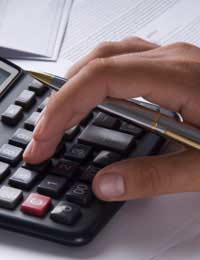How to Borrow Money That's Tax Efficient

Borrowing money is common for most types of business. What is not so common is for entrepreneurs to borrow money in the most tax efficient way possible.
Borrowing Money to Buy Equipment
Entrepreneurs can subtract from their taxable profits a proportion of what it costs them to purchase equipment. The official name of these proportions is capital allowances. They are government-set percentages of the cost of equipment. Entrepreneurs with recently established businesses can obtain a higher percentage for the tax year in which they first buy the equipment.Capital allowances apply whether an entrepreneur borrows money to buy equipment outright, or obtains the equipment with hire purchase.
In one particular instance, the government offers a 100% capital allowance. This happens when an entrepreneur provides flats for rent following the restoration or conversion of vacant areas above shops and commercial premises.
Borrowing Money from Pension Schemes
Entrepreneurs cannot usually start borrowing money that comes from the pension schemes of their businesses. There is a tax efficient exception, however: small self-administered schemes (SSAS).These schemes are for directors who hold shares in small limited companies. With certain conditions attached, an entrepreneur can borrow up to 50% of a scheme’s worth to finance capital or fixed assets.
An entrepreneur can only take out such a loan if he or she provides security, and pays one per cent or more above the clearing banks’ base rate as interest. In return, the interest is not subject to tax, and the entrepreneur claims tax relief for the interest due on the loan. In other words, the entrepreneur makes a tax efficient investment that benefits the pension scheme and the business.
Entrepreneurs should note that they must register all small self-administered pension schemes with HM Revenue & Customs before borrowing money from them. They must also create a loan agreement that has full borrowing details including the term of the loan.
Loan Interest
An entrepreneur can deduct from taxable profits the interest paid on a loan. The purpose of the loan must be to finance some aspect of the business.By extension, an entrepreneur can deduct from tax any interest paid for credit cards and overdrafts, as long as these apply solely to the business.
Individual entrepreneurs, rather than businesses, can also claim interest payments against their income tax for qualifying loans. These are loans an entrepreneur uses for share-related finance. This includes buying shares in a limited company where an entrepreneur works full-time; buying shares in or lending money to a partnership; and buying shares in or lending money to a business where the entrepreneur has a shareholding of five per cent or more.
Renting or Leasing
An entrepreneur can treat the cost of renting or leasing equipment as a tax deductible expense. This can make renting or leasing a desirable tax efficient option.Tax Efficiency Choices
Purchasing assets outright rather than leasing can also be a tax efficient investment thanks to capital allowances (see above). The best option for entrepreneurs usually depends on the nature of the business and the equipment needed. Whatever the decision, the important point is to take full advantage of the tax saving offers that are available.- A Guide to Late Payment Regulations
- Can European Banking Services Help UK Businesses?
- A Guide to Business Insurance
- Claim Your Business Tax Credits
- What Are Venture Capital Trusts?
- How to Choose a Commercial Insurer
- How to Choose the Bank That's Right for You
- What Government Grants Can You Get?
- Why You Should Consider Leasing
- Who are Venture Capitalists?
- An Introduction to Angel Investors
- Tips on Making a Pitch for Finance
- Do's and Don'ts of Using Your Own Money
- Do You Want to Get Friends and Family Involved?
- Cut Your Business Costs
- Prove Your Reliability and Commitment to the Business


Re: What is Entrepreneurs' Relief?
In my opinion I have been badly advised by my accountants --I sold my half of a bed and breakfast business in 2008(MAY) and was…
Re: What Government Grants Can You Get?
I have been running my own unique hair and beauty business successfully for 7 years. I would like now to expand and add…
Re: What Government Grants Can You Get?
i would like to start up my business but i cannot secure any grants. can anyone help. i need £20 thousand to purchase…
Re: What Government Grants Can You Get?
I'm thinking of setting up my own Security Company and going as a sole trader is there a grant or any help that i can get…
Re: What Government Grants Can You Get?
I am starting a new company, we have developed a rapid prototype with all of our fund's. we now need to apply for a…
Re: What Government Grants Can You Get?
I am a serious and passionate social entrepreneur and am looking to develop a support service across Chelmsford. I am…
Re: What Government Grants Can You Get?
Our business needs a new van can we get a grant, if we had 2 vans we could take on new staff
Re: What Government Grants Can You Get?
Is there a grant to help a new business upgrade their premises. I have a new yard with a unit that has a basic office.…
Re: What Government Grants Can You Get?
I am just going self employed as a builder, can I get a grant to buy tools to set myself up?
Re: What Government Grants Can You Get?
I am in the process of setting up my own business and have heard about a possible grant of £1,500.00 being available.…